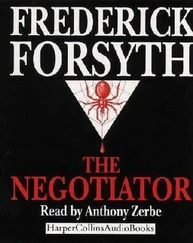Frederick Forsyth - The Devil's Alternative
Здесь есть возможность читать онлайн «Frederick Forsyth - The Devil's Alternative» весь текст электронной книги совершенно бесплатно (целиком полную версию без сокращений). В некоторых случаях можно слушать аудио, скачать через торрент в формате fb2 и присутствует краткое содержание. Жанр: Шпионский детектив, на английском языке. Описание произведения, (предисловие) а так же отзывы посетителей доступны на портале библиотеки ЛибКат.
- Название:The Devil's Alternative
- Автор:
- Жанр:
- Год:неизвестен
- ISBN:нет данных
- Рейтинг книги:5 / 5. Голосов: 1
-
Избранное:Добавить в избранное
- Отзывы:
-
Ваша оценка:
- 100
- 1
- 2
- 3
- 4
- 5
The Devil's Alternative: краткое содержание, описание и аннотация
Предлагаем к чтению аннотацию, описание, краткое содержание или предисловие (зависит от того, что написал сам автор книги «The Devil's Alternative»). Если вы не нашли необходимую информацию о книге — напишите в комментариях, мы постараемся отыскать её.
The Devil's Alternative — читать онлайн бесплатно полную книгу (весь текст) целиком
Ниже представлен текст книги, разбитый по страницам. Система сохранения места последней прочитанной страницы, позволяет с удобством читать онлайн бесплатно книгу «The Devil's Alternative», без необходимости каждый раз заново искать на чём Вы остановились. Поставьте закладку, и сможете в любой момент перейти на страницу, на которой закончили чтение.
Интервал:
Закладка:
“Comrades, I would regard it as a major defeat for our country if the killers of Yuri Ivanenko were to escape and publish their action to the world. Should that happen, I would not be able to continue my support for the policy of negotiation and further concession in the matter of our armaments levels in exchange for American grain. I would switch my support to the proposal of Party theoretician Vishnayev.”
There was dead silence.
“So would I,” said Shushkin.
Eight against four, thought Rudin as he gazed impassively down the table. Eight against four if these two shits change sides now.
“Your point is taken, Comrades,” said Rudin without a flicker of emotion. “There will be no publication of this deed. None at all.”
Ten minutes later, the meeting reopened with a unanimous expression of regret at the sudden illness of Comrade Ivanenko. The subject then turned to the newly arrived figures of wheat and grain yields.
The Zil limousine of Yefrem Vishnayev erupted from the mouth of the Borovitsky Gate at the Kremlin’s southwestern corner and straight across Manage Square. The policeman on duty in the square, forewarned by his bleeper that the Politburo cavalcade was leaving the Kremlin, had stopped all traffic. Within seconds the long, black, hand-tooled cars were scorching up Frunze Street, past the Defense Ministry, toward the homes of the privileged on Kutuzovsky Prospekt.
Marshal Kerensky sat beside Vishnayev in the latter’s car, having accepted his invitation to drive together. The partition between the spacious rear area and the driver was closed and soundproof. The curtains shut out the gaze of the pedestrians.
“He’s near to falling,” growled Kerensky.
“No,” said Vishnayev, “he’s one step nearer and a lot weaker without Ivanenko, but he’s not near to falling yet. Don’t underestimate Maxim Rudin. He’ll fight like a cornered bear on the taiga before he goes, but go he will because go he must.”
“Well, there’s not much time,” said Kerensky.
“Less than you think,” said Vishnayev. “There were food riots in Vilnius last week. Our friend Vitautas, who voted for our proposal in July, is getting nervous. He was on the verge of switching sides despite the very attractive villa I have offered him next to my own at Sochi. Now he is back in the fold, and Shushkin and Stepanov may change sides in our favor.”
“But only if the killers escape, or the truth is published abroad,” said Kerensky.
“Precisely. And that is what must happen.”
Kerensky turned in the back seat, his florid face turning brick-red beneath his shock of white hair.
“Reveal the truth? To the whole world? We can’t do that,” he exploded.
“No, we can’t There are far too few people who know the truth, and mere rumors cannot succeed. They can be too easily discounted. An actor looking precisely like Ivanenko could be found, rehearsed, seen in public. So others must do it for us. With absolute proof. The guards who were present that night are in the hands of the Kremlin elite. That leaves only the killers themselves.”
“But we don’t have them,” said Kerensky, “and are not likely to. The KGB will get them first.”
“Probably, but we have to try,” said Vishnayev. “Let’s be plain about this, Nikolai. We are not fighting for the control of the Soviet Union anymore. We are fighting for our lives, like Rudin and Petrov. First the wheat, now Ivanenko. One more scandal, Nikolai, one more. Whoever is responsible—let me make that clear, whoever is responsible—Rudin will fall. There must be one more scandal. We must ensure that there is.”
Thor Larsen, dressed in overalls and a safety helmet, stood on a gantry crane high above the dry dock at the center of the Ishikawajima-Harima shipyard and gazed down at the mass of the vessel that would one day be the Freya.
Even three days after his first sight, the size of her took his breath away. In his apprenticeship days, tankers had never gone beyond 30,000 tons, and it was not until 1956 that the world’s first over that tonnage took the sea. They had to create a new class for such vessels, and called them supertankers. When someone broke the 50,000-ton ceiling, there was another new class, the VLCC, or Very Large Crude Carrier. As the 200,000-ton barrier was broken in the late sixties, the new class of Ultra Large Crude Carrier, or ULCC, came into being.
Once, at sea, Larsen had seen one of the French leviathans, weighing in at 550,000 tons, move past him. His crew had poured out on deck to watch her. What lay below him now was twice that size. As Wennerstrom had said, the world had never seen the like of her, nor ever would again.
She was 515 meters long, or 1,689 feet, or ten city blocks. She was 90 meters broad, or 295 feet from scupper to scupper, and her superstructure reared five stories into the air above her deck. Far below what he could see of her deck area, her keel plunged 36 meters, or 118 feet, toward the floor of the dry dock. Each of her sixty holds was bigger than a neighborhood cinema. Deep in her bowels below the superstructure, the four steam turbines mustering a total of 90,000 shaft horsepower were already installed, ready to drive her twin screws, whose 40-foot-diameter bronze propellers could be vaguely seen glinting below her stern.
From end to end she teemed with antlike figures, the workers preparing to leave her temporarily while the dock was filled. For twelve months, almost to the day, they had cut and burned, bolted, sawed, riveted, hacked, plated, and hammered the hull of her together. Great modules of high-tensile steel had swung in from the overhead gantries to drop into preassigned places and form her shape. As the men cleared away the ropes and chains, lines and cables that hung about her, she lay exposed at last, her sides clean of encumbrances, painted twenty coats of rustproof paint, waiting for the water.
At last, only the blocks that cradled her remained. The men who had built this, the biggest dry dock in the world, at Chita, near Nagoya on Ise Bay, had never thought to see their handiwork put to such use. It was the only dry dock that could take a million-tonner, and it was the first and last it would ever hold. Some of the veterans came to peer across the barriers to see the ceremony.
The religious ceremony took half an hour as the Shinto priest called down the blessings of the divine ones on those who had built her, those who would work on her yet, and those who would sail her one day, that they should enjoy safe labor and safe sailing. Thor Larsen attended, barefoot, with his chief engineer and first officer, the owner’s chief superintendent (marine architect), who had been there from the start, and the yard’s equivalent architect. The latter were the two men who had really designed and built her.
Shortly before noon the sluices were opened, and with a thundering roar the western Pacific began to flow in.
There was a formal lunch in the chairman’s office, but when it was over, Thor Larsen went back to the dock. He was joined by his first officer, Stig Lundquist, and his chief engineer, Bjorn Erikson, both from Sweden.
“She’s something else,” said Lundquist as the water climbed her sides.
Shortly before sunset the Freya groaned like an awaking giant, moved half an inch, groaned again, then came free of her underwater supports and rode the tide. Around the dock, four thousand Japanese workers broke their studied silence and burst into cheering. Scores of white helmets were thrown into the air; the half-dozen Europeans from Scandinavia joined in, pumping hands and thumping backs. Below them the giant waited patiently, seemingly aware her turn would come.
The next day, she was towed out of the dock to the commissioning quay, where for three months she would once again play host to thousands of small figures working like demons to prepare her for the sea beyond the bay.
Читать дальшеИнтервал:
Закладка:
Похожие книги на «The Devil's Alternative»
Представляем Вашему вниманию похожие книги на «The Devil's Alternative» списком для выбора. Мы отобрали схожую по названию и смыслу литературу в надежде предоставить читателям больше вариантов отыскать новые, интересные, ещё непрочитанные произведения.
Обсуждение, отзывы о книге «The Devil's Alternative» и просто собственные мнения читателей. Оставьте ваши комментарии, напишите, что Вы думаете о произведении, его смысле или главных героях. Укажите что конкретно понравилось, а что нет, и почему Вы так считаете.










